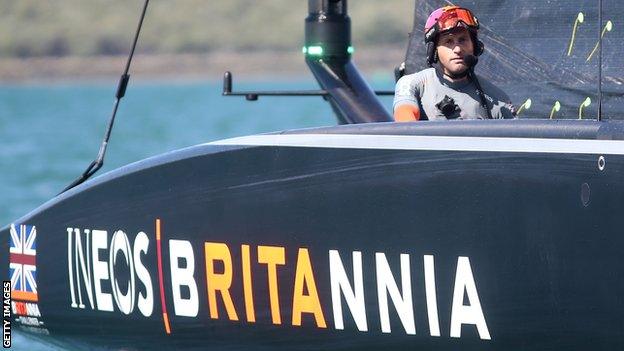Ineos Britannia and Mercedes F1 join forces for America's Cup challenge
- Published

Sir Ben Ainslie will skipper Ineos Britannia in the 37th America's Cup
Sir Ben Ainslie's Ineos Britannia has joined forces with the Mercedes Formula 1 team in their quest to win the next America's Cup.
Ainslie and Ineos hope Mercedes F1's technology combined with his team's sailing expertise will produce a boat that can challenge for victory in 2024.
Ineos were eliminated in the Challenger Series at this year's 36th Cup.
Ainslie said: "We need to take it to the next level to take on the mighty Kiwis, the All Blacks of sailing."
Ineos boss Sir Jim Ratcliffe said: "What we learned in New Zealand is we had a sailing team capable of winning the America's Cup but the boat wasn't good enough.
"If we don't have a boat on the start line that's capable of winning, it's like putting Lewis (Hamilton) in a slow car. He might be a very, very good driver but he isn't going to win in a slow car.
"But having a fast boat is no guarantee of winning. The objective of the team is to get to the start line with a boat that's got the potential of winning."
Learning from past errors
Mercedes were involved at the very end of Ineos' last America's Cup campaign, after the chemicals giant became a main sponsor of the F1 team before the 2020 F1 season. Before the 2021 championship, their relationship was extended when Ineos became a one-third shareholder in Mercedes F1.
Mercedes F1 chief technical officer James Allison, who will be the technical lead on the America's Cup project, said: "When people talk about the America's Cup being like F1 on water, most people are thinking: 'It's a bit hydrodynamic, it's a bit aerodynamic, it's technological'.
"But the most striking comparison to me is that it's difficult.
"And the way it's worked OK for us in F1 is having the humility to admit that it's difficult and that your competitors will eat you up if for a moment you stop remembering that it's difficult. And this challenge is proper difficult.
"Last time, we knew of some of the difficulties the team had endured and were involved in trying to reduce some of them and in trying to help the boat become more competitive.
"But we knew that fixing some of them would have involved a time machine. We would have had to go back and make a few decisions differently at the start of the campaign and it could have run in a different direction.
"So we find ourselves at the beginning of a fresh one with the combined learning of the Ineos team and the part we played in the previous one coupled with all the people who've joined us from other campaigns for this one.
"We are tying to make sure all our knowledge is pooled at the beginning so we don't wish we had a time machine two years from now. We feel we have stepped through this complicated design space in a good way to bring that boat that Jim talks about, the boat good enough to give Ben and the other sailors a chance to win."
How can F1 help sailing?
Ineos Britannia's boat design concept will be led by Martin Fischer, who has joined from Luna Rossa, the team that beat Ineos UK in the Challenger Series this year.
Experienced F1 designer Geoff Willis, technical director of Mercedes Applied Sciences and Ineos Britannia, said there were a number of areas in which F1 technology could help design a faster boat.
"There are overlaps," Willis said. "We have foils and in F1 we understand that sort of aerodynamics and hydrodynamics.
"There are things we aren't used to doing - the free-surface effect and the fact you have these foils operating quite close to the surface of the water. And we've got flexing and lifting aerodynamic devices in the form of sails, which are slightly new. But we have lots of flow features which we understand well.
"As well as the technical aspects of the aerodynamics and hydrodynamics, you've got the structural aspects of a composite structure hull, very similar in concept to how we build our chassis, and then there are lots of hydraulic systems, gearboxes for transferring the power from the grinders, quite a lot of engineering tools.
"But I think what's more similar is that these are high-performance difficult problems to solve. In some ways it's the mindset and ability to bring in resources from lots of different directions and the need to have a holistic design to balance off pure performance with what you can achieve in the timescale.
"Bluntly, we don't have enough time do the America's Cup boat; we never have enough time to do the race car. We are always up against those pressures and a lot of that is what I am hoping to bring that experience from the F1 world into the experience that all the Cup guys have got."

